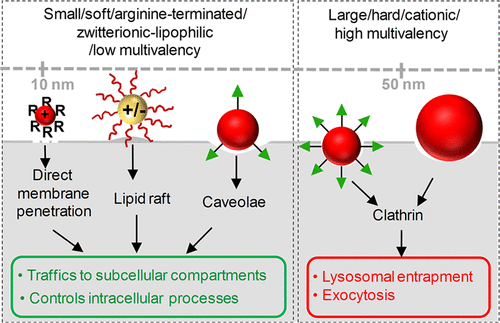当前位置:
X-MOL 学术
›
Acc. Chem. Res.
›
论文详情
Our official English website, www.x-mol.net, welcomes your feedback! (Note: you will need to create a separate account there.)
Chemically Designed Nanoscale Materials for Controlling Cellular Processes
Accounts of Chemical Research ( IF 18.3 ) Pub Date : 2021-07-07 , DOI: 10.1021/acs.accounts.1c00215 Koushik Debnath 1 , Suman Pal 1 , Nikhil R Jana 1
Accounts of Chemical Research ( IF 18.3 ) Pub Date : 2021-07-07 , DOI: 10.1021/acs.accounts.1c00215 Koushik Debnath 1 , Suman Pal 1 , Nikhil R Jana 1
Affiliation

|
Nanoparticles are widely used in various biomedical applications as drug delivery carriers, imaging probes, single-molecule tracking/detection probes, artificial chaperones for inhibiting protein aggregation, and photodynamic therapy materials. One key parameter of these applications is the ability of the nanoparticles to enter into the cell cytoplasm, target different subcellular compartments, and control intracellular processes. This is particularly the case because nanoparticles are designed to interact with subcellular components for the required biomedical performance. However, cells are protected from their surroundings by the cell membrane, which exerts strict control over entry of foreign materials. Thus, nanoparticles need to be designed appropriately so that they can readily cross the cell membrane, target subcellular compartments, and control intracellular processes.
中文翻译:

用于控制细胞过程的化学设计纳米级材料
纳米粒子作为药物递送载体、成像探针、单分子跟踪/检测探针、用于抑制蛋白质聚集的人工伴侣以及光动力治疗材料被广泛应用于各种生物医学应用中。这些应用的一个关键参数是纳米颗粒进入细胞质、靶向不同亚细胞区室和控制细胞内过程的能力。情况尤其如此,因为纳米颗粒被设计为与亚细胞成分相互作用以获得所需的生物医学性能。然而,细胞受到细胞膜的保护,不受周围环境的影响,细胞膜严格控制外来物质的进入。因此,需要适当设计纳米粒子,以便它们可以轻松穿过细胞膜,靶向亚细胞区室,
更新日期:2021-07-20
中文翻译:

用于控制细胞过程的化学设计纳米级材料
纳米粒子作为药物递送载体、成像探针、单分子跟踪/检测探针、用于抑制蛋白质聚集的人工伴侣以及光动力治疗材料被广泛应用于各种生物医学应用中。这些应用的一个关键参数是纳米颗粒进入细胞质、靶向不同亚细胞区室和控制细胞内过程的能力。情况尤其如此,因为纳米颗粒被设计为与亚细胞成分相互作用以获得所需的生物医学性能。然而,细胞受到细胞膜的保护,不受周围环境的影响,细胞膜严格控制外来物质的进入。因此,需要适当设计纳米粒子,以便它们可以轻松穿过细胞膜,靶向亚细胞区室,


























 京公网安备 11010802027423号
京公网安备 11010802027423号